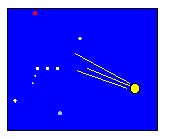 |
Astronomy 101 Problem Set #4 |  |
This Problem Set is due by 1:00 pm on Thursday, 29 September
 |
Astronomy 101 Problem Set #4 |  |
This Problem Set is due by 1:00 pm on Thursday, 29 September
Problem #1: In the spring of 2004, astronomers announced the discovery of a large, almost planet-sized rock deep in the outer reaches of our solar system. Some people have called this object the tenth planet, and have given it the name "Sedna." Sedna is about the size of Pluto, but it has an orbital period of 10500 years.
a) Calculate the semi-major axis of Sedna's orbit.
b) Astronomers have calculated that Sedna's "perihelion" distance (i.e., the closest it will ever get to the Sun) is 75 A.U. Based on this information, and the semi-major axis you calculated in part a), calculate the eccentricity of Sedna's orbit. (This is tricky -- try using some diagrams to help you make sense out of things. Note that a planet on an elliptical orbit is closest to the the Sun when it is at the "end" of the ellipse, i.e., crossing the line defined by the two foci.)
Problem #2: A couple of problems with wavelengths and frequencies:
a) That annoying beep on your microwave is actually a sound wave with frequency of about 3000 Hz. Assuming that the speed of sound waves is 330 m/s, calculate the wavelength of this sound wave.
b) Radio broadcasts from WVBU produce light waves with frequency 90.5 MHz ("mega"Hz, or "millions of Hz"). Calculate the wavelength of these waves. (Beware! Radio waves are light waves and do not travel at the speed of sound.)
Problem #3: The Copernicus crater on the surface of the Moon has a diamter of 80 km.
a) If the moon is 3.84 x 105 km away, what is the angular size of the Copernicus crater?
b) Would you be able to resolve this crater with your eye (diameter= 5mm) in visible light (wavelength = 500 nm)?
